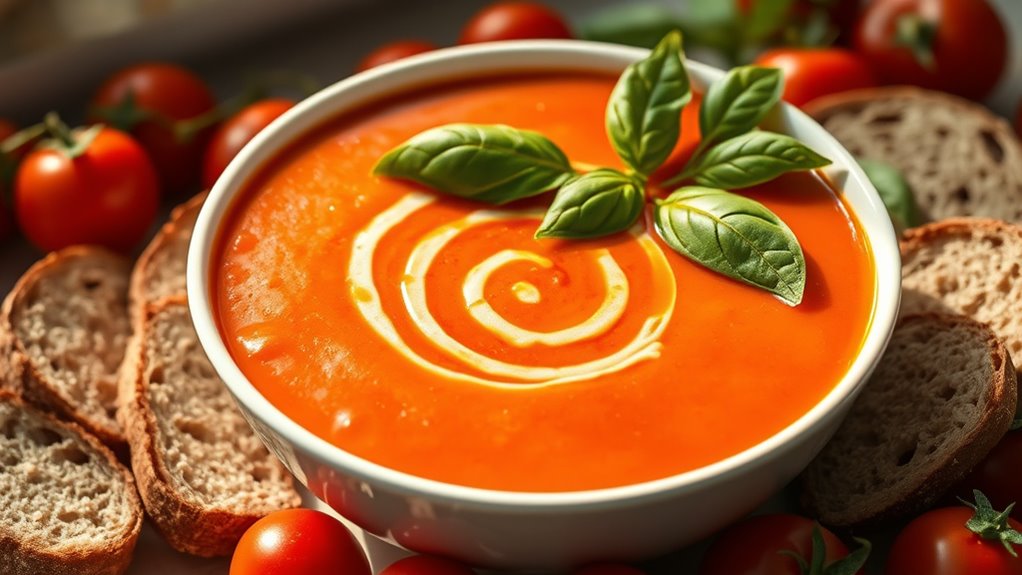For a dairy-free tomato soup, start with pantry staples like crushed tomatoes, vegetable broth, olive oil, garlic, onion, and fresh basil. Sauté the onion and garlic in oil until soft, then add the tomatoes and broth and simmer to blend flavors. Season with salt, pepper, and optional herbs like basil or oregano; you can finish with dairy-free cream or a splash of plant milk for creaminess. If you keep exploring, you’ll uncover more tips and tweaks.
Ingredients and Quantity
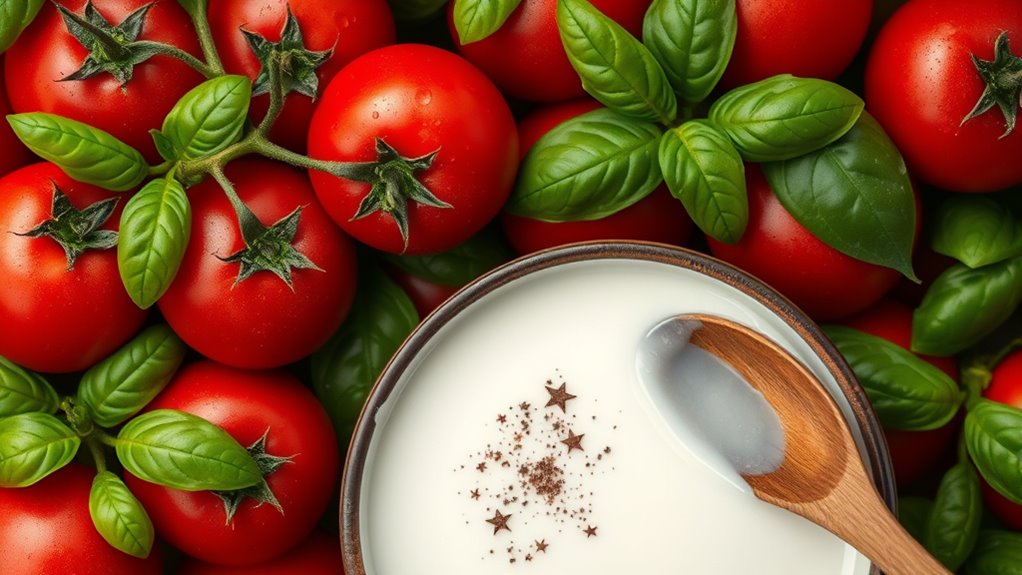
The ingredients for this dairy-free tomato soup are simple and pantry-friendly: canned crushed tomatoes, vegetable broth, olive oil, garlic, onion, fresh basil, salt, and pepper. You’ll also consider tomato varieties and seasoning options to tailor flavor. Use a bright acidity from crushed tomatoes and balance with broth, olive oil, and herbs. For texture, choose crushed or diced tomatoes. Measurements stay consistent with 4 cups broth, 28-ounce tomatoes, 2 cloves garlic, 1 small onion, 2 tablespoons oil, salt, pepper, and a handful of basil. Tomato varieties influence sweetness and depth, while seasoning options let you dial in heat or brightness.
| Tomato Varieties | Seasoning Options | Flavor Intensity |
|---|---|---|
| San Marzano | Basil, oregano | Mild |
| Roma | Thyme | Medium |
| Abundant cherry | Red pepper flakes | Bright |
| Heirloom | Smoked paprika | Robust |
| Olive tomato | Garlic powder | Balanced |
Preparations
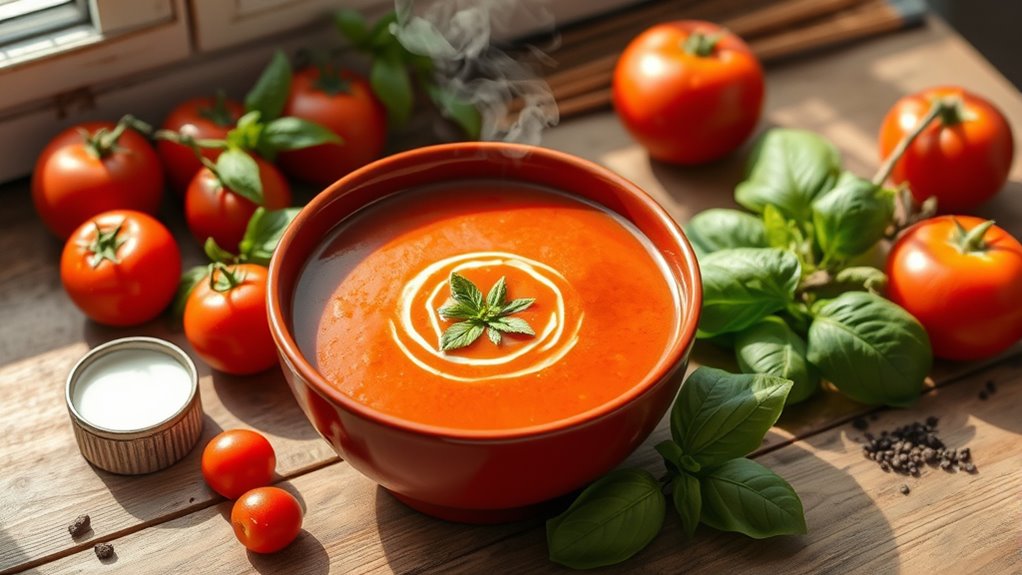
Once you’ve prepped the ingredients, start by heating the olive oil in a large pot over medium heat. You’ll sauté onions and garlic until fragrant, then add tomatoes and broth, stirring to coat. Use evidence-based steps: maintain steady heat, avoid scorching, and adjust seasonings gradually. For preparation techniques, bloom spices briefly to release aroma, then simmer to deepen flavor without overcooking. If you prefer smoother texture, blend partially or fully after cooking, depending on your texture goal. Ingredient substitutions can include plant-based cream or dairy-free milk for creaminess, and coconut milk or almond milk as alternatives to broth for body. Keep a mindful eye on sodium, replacing salt with herbs and citrus to enhance brightness. Store leftovers promptly, refrigerate, and reheat gently to preserve flavor and nutrition.
Kitchen tools or Kitchenware Required
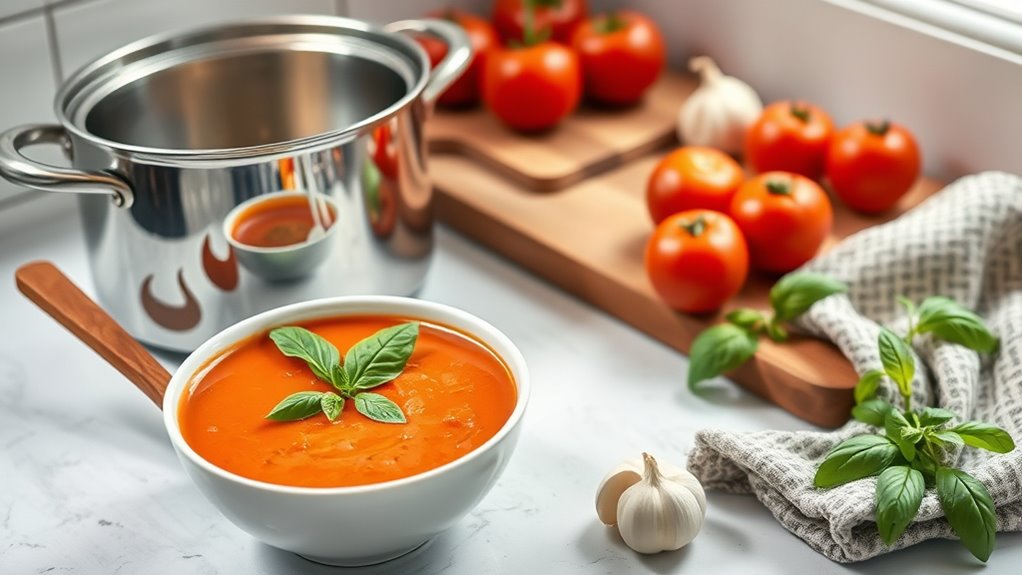
A well-equipped kitchen makes this dairy-free tomato soup straightforward, with a few essential tools to keep prep efficient. You’ll rely on a reliable blender, a sturdy pot, a heatproof spoon, and accurate measuring cups for consistent results. In addition, cutting boards and a sharp knife guarantee safe prep, while a sieve helps create a smooth texture if desired. For organization, have a timer and a ladle handy to monitor simmer and portion.
| Tool category | Why it matters |
|---|---|
| Blender types | Smooths tomatoes and emulsifies flavors for consistency |
| Cutting boards | Protects surfaces and keeps ingredients clean and separated |
How to Cook
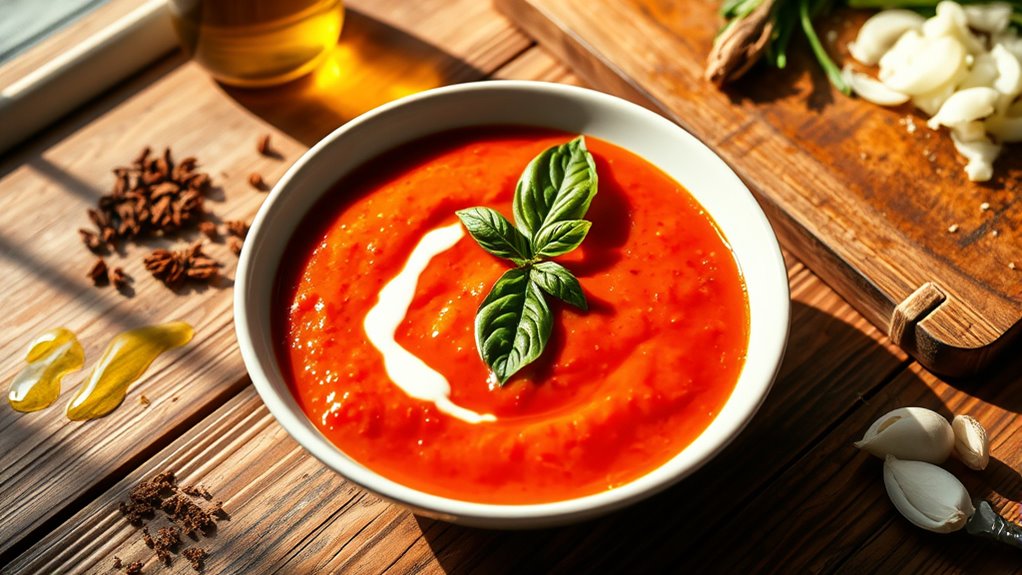
- Sauté onions and garlic in a splash of olive oil until translucent.
- Add crushed tomatoes and stock to create a flavorful base.
- Simmer gently, watching for a cohesive texture.
- Stir in a pinch of salt, pepper, and a splash of plant-based cream or dairy-free milk for extra body if desired.
- Let flavors marry by continuing to simmer.
- Season gradually and taste as you go.
- Adjust acidity with a touch of sugar if needed.
- For soup variations, add roasted peppers, cumin, or smoked paprika to alter the flavor profile without sacrificing clarity.
- Maintain a simmer rather than boiling to prevent harsh flavors.
- Use these evidence-based cooking techniques to tailor textures and seasonings to your preferences while mastering core cooking skills.
How to Serve
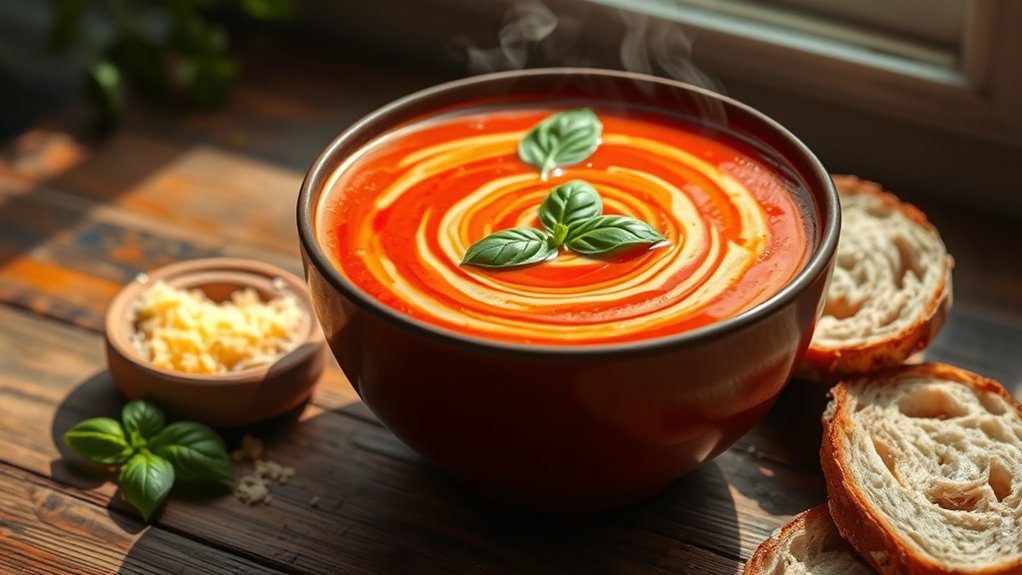
To serve dairy-free tomato soup, start by ladling warm portions into bowls and optionally topping with fresh herbs like basil or a drizzle of olive oil for extra depth. This approach aligns with evidence-based serving habits that emphasize warmth, aroma, and balance. Use these serving suggestions to enhance flavor without dairy.
- garnish options: finish with a sprinkle of nutritional yeast for a cheesy note or chopped chives for brightness.
- serving suggestions: pair with crusty bread or a light side salad to create a balanced meal.
- texture tweaks: offer a drizzle of olive oil or a dollop of dairy-free yogurt on the side for guests to customize.
- portion control: serve consistent portions to guarantee comfort and appetite satisfaction.
Tips
When making dairy-free tomato soup, small tweaks can boost flavor and texture without adding dairy. You’ll optimize taste by embracing controlled heat, careful sweating of aromatics, and selective roasting to concentrate sweetness. Use cooking techniques like dry sauté to deepen onions, then deglaze with water or stock to preserve brightness. For texture, consider a brief simmer with a splash of olive oil emulsified at the end to create body without dairy cream. Flavor enhancements come from ripe tomatoes, a pinch of sugar if needed, and a touch of acid like lemon juice or vinegar to brighten. Avoid overcooking; taste as you go and adjust salt gradually. True freedom in cooking means precise, evidence-based tweaks that respect ingredients.
Food Value and Benefit
Dairy-free tomato soup is a nutrient-rich dish that offers significant health benefits while accommodating dairy-free dietary preferences. This recipe provides valuable vitamins and minerals that contribute to overall wellness.
Food Value of Prepared Dish:
- Rich in lycopene, a powerful antioxidant found in tomatoes
- Contains vitamin C, which supports immune function and skin health
- Provides potassium, essential for maintaining healthy blood pressure and heart function
- Includes dietary fiber that promotes digestive health and satiety
Benefits of Eating This Recipe:
- Supports antioxidant defense, helping to protect cells from oxidative damage
- Enhances circulation and cardiovascular health through potassium content
- Aids digestion and helps manage weight by increasing fiber intake
- Improves nutrient absorption as cooking increases bioavailability of carotenoids
- Suitable for those with dairy allergies or sensitivities, making it inclusive for diverse dietary needs
Frequently Asked Questions
Can I Freeze Tomato Soup Dairy Free?
Yes, you can freeze tomato soup dairy free. When you do, use freezing techniques and store in proper storage containers; cool first, portion, label, and keep airtight for up to 3 months for best texture and safety.
Which Dairy-Free Milk Alternatives Work Best?
You’ll find almond milk and coconut milk work best; they blend smoothly and don’t overpower tomato flavor, offering creamy texture. Evidence suggests unsweetened varieties maintain nutrition, while you should choose fortified options if you need calcium and vitamin D.
How Long Does Tomato Soup Stay Refrigerated?
Tomato soup stays refrigerated for about 3–4 days. For ideal Shelf Life, store in airtight containers and reheat gently. Follow Storage Tips: cool promptly, label dates, and discard if you notice off odors or mold. You’ve got this.
Is Roasted Tomato Soup Dairy Free?
Roasted tomato soup can be dairy free, as long as you skip dairy additions. You’ll notice a roasted flavor by using diverse tomato varieties; just make sure no cream, butter, or cheese sneaks in. Your freedom to customize stays intact.
Can I Add Protein to This Soup?
Yes, you can add protein to this soup. Adding legumes or other protein sources boosts satiety. Consider chickpeas, lentils, or dairy-free tofu; adjust simmer time and liquid to maintain texture and guarantee full flavor integration.
